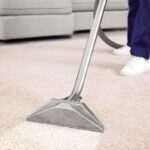Wool is a popular choice of fabric for a carpet, and for good reason. This natural material is soft, durable and warm, and it makes for a beautiful addition to any room. Knowing how to care for, and clean, wool carpets is important, however, because it’s not a forgiving material if you don’t clean it in the right way and it requires careful maintenance. It would be a shame to go to the effort and expense of purchasing a wool carpet to then only ruin it by using incorrect or unsuitable cleaning methods. Therefore, if you’re looking for safe, reliable and effective wool carpet cleaning solutions and tips, read on.
1. Vacuum your wool carpet regularly
One of the positives of owning a wool carpet is that it’s very good at hiding the dirt that collects in it over time. However, this doesn’t mean to say that you should neglect getting it cleaned, because the accumulated dirt can degrade the natural wool fibres over time, causing them damage.
It’s, therefore, a good idea to get into a routine of vacuuming your wool carpets at least once per week, or every other day if the carpet is located in a high-traffic area, or used by children and pets.
2. Use the right vacuum machine
Wool is a naturally thick material, which means it can be harder to vacuum compared to synthetic fibre carpets. Therefore, having a wool safe carpet cleaning machine when vacuuming is crucial.
Choose a machine that has a plain suction head. Avoid using a machine that has a stiff, bristled brush as this could damage the fibres, and don’t use a rotary machine as this could pull on the carpet, potentially causing it to fray.
3. Vacuuming method
Because wool is a thick material, it’s pretty good at hiding dirt in its fibres. Some of this might not be suitable for being vacuumed, and could even damage your machine, so it’s worth doing a quick check over your carpet for any hidden items in it, such as toy pieces, pen lids, coins, pins, etc, before you get your hoover out.
Once you start vacuuming, cover the entire area, taking it slowly. After you’ve finished vacuuming in one direction, you’ll need to repeat the process in the other direction, so you can be confident that as much of the hidden dirt has been accessed by your machine.
4. Removing stains
It’s inevitable that at some point something might get spilled or dropped onto your wool carpet, and you’ll need to make sure that you can remove any stains as safely, thoroughly and carefully as possible.
Wool carpets are made up of overlapping scales. This lets the carpet breathe, but, at the same time, this makes it easier to absorb spills, which penetrate deeper into the carpet pile. The natural oil in wool, called lanolin, is also good at picking up dirt, meaning that tackling stains and dirt quickly in a wool carpet is really important.
As with any carpet stain, the first thing you should do is blot it with a clean, absorbent cloth or kitchen paper to soak up the excess moisture.
Never rub or scrub at the spillage as this could set it deeper into the wool carpet, making it more difficult to remove, or even to become permanent.
When blotting the spillage, use inward, circular motions to prevent the stain from spreading out further into the carpet.
If something solid has been spilled onto the carpet, before you start blotting it, scoop up any excess substance using a spatula.
When it comes to removing the stain itself, make sure that you use a wool safe carpet cleaning product that’s pH neutral, and always follow the manufacturer’s instructions on the label. Avoid using any products containing bleaches, as these could destroy the fibres in the carpet, and if you use an enzyme cleaner, make sure to thoroughly rinse it from the carpet, as this can cause wool fibres to degrade.
Always carry out a patch test on a hidden part of the carpet before using any stain remover or other cleaning solution on your wool carpet, so you can check to see whether it’s suitable and safe.
You could also try mixing a small amount of gentle detergent with warm water and apply to the stain, or for tougher stains that may smell, a combination of vinegar and water often does the trick.
Wool doesn’t like being exposed to excessive moisture as it will easily absorb this, potentially damaging fibres and encouraging mould growth deep in the carpet underlay. Therefore, be mindful of how much water you use on the carpet when trying to clean it.
If you don’t want to take any risks, because, after all, wool can be a sensitive fabric to clean, it’s preferable to contact a professional wool carpet cleaning company, like Carpet Bright UK, to get rid of carpet stains for you.
5. Deep cleaning your wool carpets
The dense fibres in wool carpets make them an easy target for dirt and dust accumulation, whilst natural fabrics like wool are inviting to bacteria. Although vacuuming and spot cleaning your wool carpets can help to maintain them, this won’t be enough alone, so they’ll need deep cleaning about twice per year.
Since wool is a much more sensitive material to clean than synthetic fabrics, experts don’t recommend that you try to deep clean wool carpets yourself with machines that you can hire, as these could distort the carpet’s structure. Instead, choose a reputable carpet and upholstery cleaning London business, like ours, who specialise in cleaning fabrics like wool.
A professional cleaning company will use industrial machines that are able to access the hidden, deep down dirt that can be prevalent in wool carpets, whilst ensuring that the carpet is cleaned safely, using methods that are compatible with wool. Professional cleaning services will also eliminate odours and allergens from wool carpets, which are notorious for getting trapped inside the thick fibres of the carpet.
When your wool carpets next need a deep clean, why not give our carpet, rug and upholstery cleaning London experts at Carpet Bright UK a call?







